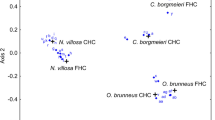Abstract
(E)-10-Dodecen-1-yl acetate (E10–12∶Ac) and (E,E)-8,10-dodecadien-1-ylacetate (E,E8,10–12∶Ac) are sex attractants for males of the pea moth,Cydia nigricana (F.). Thirty-two structurally related compounds with chain lengths of 9–14 carbon atoms were exposed withE10–12∶Ac orE,E8,10–12∶Ac in traps in the field to investigate their influence on the activity of the attractants. Only alchols and acetates unsaturated at C-8, -9, or -10 greatly influenced moth captures. (Z) and (E)-8-dodecen-1-ol were weak synergists forE10–12∶Ac but no synergists forE,E8,10–12∶Ac were found. (Z) and (E)-8-dodecen-1-yl acetate and (E,E)-8,10-dodecadien-1-ol inhibited bothE10–12∶Ac andE,E8,10–12∶Ac while (E)-10-dodecen-1-ol, 10-dodecyn-1-ol, (Z) and (E)-9-dodecen-1-yl acetate, (Z)-10-dodecen-1-yl acetate, and undecyl acetate inhibited only the former attractant.
Similar content being viewed by others
References
Arn, H., Schwarz, C., Limacher, H., andMani, E., 1974. Sex attractant inhibitors of the codling mothLaspeyresia pomonella L.Experientia 30:1142–1144.
Beroza, M., Staten, R.T., andBierl, B.A. 1971. Tetradecyl acetate and related compounds as inhibitors of attraction of the pink bollworm moth for the sex lure hexalure.J. Econ, Entomol. 64:580–582.
Beroza, M., Bierl, B.A., andMoffitt, H.R. 1974. Sex pheromones: (E,E)-8,10-dodecadien-1-ol in the codling moth.Science 183:89–90.
Boekh, J. 1980. Neural mechanisms of odour detection and odour discrimination in the insect olfactory pathway, pp. 367–374,in M. Sherwood (ed.). Insect Neurobiology and Pesticide Action. Proceedings of a conference of the Society of Chemical Industry, University of York, September 1979.
George, D.A., McDonough, L.M., Hathaway, D.O., andMoffitt, H.R. 1975. Inhibitors of sexual attraction of male codling moths.Environ. Entomol. 4:606–608.
Greenway, A.R., andWall, C. 1980.Rep. Rothamsted Exp. Sta. 1979, Pt. 1, 117.
Greenway, A. R., andWall, C. 1981. Attractant lures for males of the pea moth,Cydia nigricana (F.), containing (E)-10-dodecen-1-yl acetate and (E,E)-8,10-dodecadien-1-yl acetate.J. Chem. Ecol. 7:563–573.
Hathaway, D.O., McGovern, T.P., Beroza, M., Moffitt, H.R., McDonough, L.M., andButt, B. A. 1974. An inhibitor of sexual attraction of male codling moths to a synthetic sex pheromone and virgin females in traps.Environ. Entomol. 3:522–524.
Hathaway, D.O., McDonouoh, L.M., George, D.A., andMoffitt, H.R. 1979. Antipheromone of the codling moth: potential for control by air permeation.Environ. Entomol. 8:318–321.
Klun, J.A., andRobinson, J.F. 1972. Olfactory discrimination in the European corn borer and several pheromonally analogous moths.Ann. Entomol. Soc. Am. 65:1337–1340.
Lewis, T., Wall, C., Macaulay, E. D. M., andGreen Way, A. R. 1975. The behavioral basis of a pheromone monitoring system for pea moth.Cydia nigricana. Ann. Appl. Biol. 80:257–274.
Lewis, T., andMacaulay, E.D.M. 1976. Design and elevation of sex attractant traps for pea moth,Cydia nigricana (Steph.), and the effect of plume shape on catches.Ecol. Entomol. 1:175–187.
McLaughlin, J.R., Gaston, L.K., Shorey, H.H., Hummel, H.E., andStewart, F.D. 1972. Sex pheromones of Lepidoptera, XXX111. Evaluation of the disruptive effect of tetradecyl acetate on sex pheromone communication inPectinophora gossypiella.J. Econ. Entomol. 65:1592–1593.
Minks, A.K., Voerman, S., andKlun, J.A. 1976. Disruption of pheromone comunication with micro-encapsulated antipheromones againstAdoxophyes orana.Entomol. Exp. Appl. 20:163–169.
Perry, J.N., Wall, C., andGreenway, A.R. (1980) The use of Latin square designs in field experiments involving insect sex attractants.Ecol. Entomol. 5:385–396.
Preiss, R., andPriesner, E. 1978. Neue Laborverfahren zur Wirksamekeitsbestimmung von Lockstoffen und Lockstoff-Inhibitoren beim ApfelwicklerLaspeyresia pomonella (L.).Min. Dtsch. Ges. Allg. Angew. Entomol. 1:166–169.
Priesner, E. 1980. Sensory encoding of pheromone signals and related stimuli in male moths, pp. 359–366,in M. Sherwood (ed.). Insect Neurobiology and Pesticide Action. Proceedings of a conference of the Society of Chemical Industry. University of York, September 1979.
Roelofs, W.L. andComeau, A. 1971. Sex pheromone perception: synergists and inhibitors for the red-banded leaf roller attractant.J. Insect Physiol. 17:435–449.
Roelofs, W.L., Comeau, A., Hill, A., andMilicevic, G. 1971. Sex attractant of the codling moth: characterization with electroantennogram technique.Science 174:297–299.
Roelofs, W.L., Hill, A.S., andCardé, R. 1975. Sex pheromone components of the redbanded leafroller,Argyrotaenia velutinana (Lepidoptera, Tortricidae).J. Chem. Ecol. 1:83–89.
Taylor, L.R., Woiwod, I.P., andPerry, J.N. 1978. The density-dependence of spatial behavior and the rarity of randomness.J. Anim. Ecol. 47:383–406.
Voerman, S., Minks, A.K., andHoux, N.W.H. 1974. Sex pheromones of summerfruit tortrix moth,Adoxophyes orana: Investigations on compounds modifying their attractancy.Environ. Entomol. 3:701–704.
Wall, C., andGreenway, A.R. 1981. Anattractant lure for use in pheromone monitoring traps for the pea moth,Cydia nigricana (F.).Plant Pathol. 30:73–76.
Wall, C., andPerry, J.N. 1978, Interactions between pheromone traps for the pea mothCydia nigricana (F.).Enlomol Exp. Appl. 24:155–162.
Wall, C., Greenway, A.R., andBurt, P.E. 1976. Electroantennographic and field responses of the pea moth,Cydia nigricana, to sex attractants and related compounds.Physiol. Entomol. 1:151–157.
Author information
Authors and Affiliations
Rights and permissions
About this article
Cite this article
Greenway, A.R., Wall, C. & Perry, J.N. Compounds modifying the activity of two sex attractants for males of the pea moth,Cydia nigricana (F.). J Chem Ecol 8, 397–408 (1982). https://doi.org/10.1007/BF00987788
Received:
Revised:
Issue Date:
DOI: https://doi.org/10.1007/BF00987788




